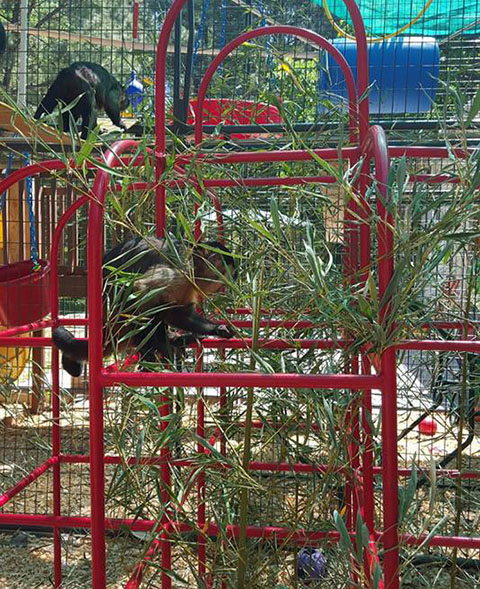By Janice Metzger

“Browse”, as it relates to primate diets, is plant material such as leaves, vines, berries, twigs and even branches. Wild-living primates consume many types of plant materials that are native to the regions in which they live. Browse is an important part of our captive-living primates’ diets as well. Though we do not have access to the native plants of our primates’ ancestral homes, many common plants in the U.S. are suitable to be fed as browse to our primates.
Browse supplies more fiber than even the high-fiber commercial biscuits, and more fiber than many of the vegetables that we feed to our primates. Fiber is an essential element in our primates’ diet as their “gut,” or intestinal tract utilizes fiber to properly digest and metabolize the food they eat. Primates need substantially more fiber in their diets than humans do. Not only does browse supply essential fiber, but is also a source of enrichment as our monkeys explore and manipulate the plant materials; picking the leaves and berries off the stems and stripping the bark from the branches.
Following is a list of primate-safe plants than can be used for browse. This list is published by the National Research Council, thus is a trusted source. Many of these plants can be grown in our own yards and gardens, providing us with a continuous source of browse for our primates’ diets.
Plant Species Used in Feeding Captive Primates
National Research Council of the National Academies
Nutrient Requirement of Nonhuman Primates
Second Revised Edition, 2003
Alder (Alnus spp.)
Alfalfa (Medicago sativa)
American holly (Ilex opaca)
Bamboo (Pseudosasa spp., Phyllostachys spp.)
Beech (Fagus spp.)
Blackberry (Rubus betuifolius)
Brush cherry (Syzgium paniculatum)
Buckthorn (Bumelia tena)
Cabbage palm (Sabel palmetto)
Carolina cherry laurel (Prunus caroliniana)
Chinaberry (Melia azedarach)
Common Nightshade (Solanum nigrum)
Cup-of-gold (Solandra guttata)
Fig (Ficus carica)
Fig (Ficus glomerata)
Fig (Ficus macrophulla)
Fig (Ficus nittida)
Fig (Ficus retusa)
Fig (Ficus rubiginosa)
Fig (Ficus rumphii)
Fig (Ficus thonningii)
Flowering dogwood (Cornus florida)
Grape (Vitis spp.)
Giant cane (Arundinaria gigantean)
Hackberry (Celtis occidentalis georgiana)
Hercules’ club (Zanthoxylum clava-herculis)
Hibiscus (Hibiscus rosa-sinesis)
Kudzu (Pueraria hirsuta)
Live oak (Quercus virginiana)
Loblolly pine (Pinus taeda)
Mangrove (Rhizophora spp.)
Maple (Acer spp.)
Mexican tea (Chenopodium ambrosiodes)
Mulberry (Morus spp.)
Muscadine grape (Vitis retundifolia)
Nut muscadine (Vitis cinerea)
Persimmon (Diospyros virginiana)
Red bay (Persea borbonia)
Red cedar (Juniperus silicicild)
Resurrection fern (Polypodium polypoides)
Small pignut (Carya ovalis)
Southern bayberry/wax myrtle (Myrica cerifera)
Southern magnolia (Magnolia grandiflora)
Spanish moss (Tillandsia usneoides)
Sparkleberry (Vaccinium arboretum)
Sugarberry (Celtis laevigata)
Virginia creeper (Parthenocissus quinquefolia)
Weeping Chinese banyan (Ficus benjamina)
Willow (Salix spp.)
Yaupon (Ilex vomitoria)